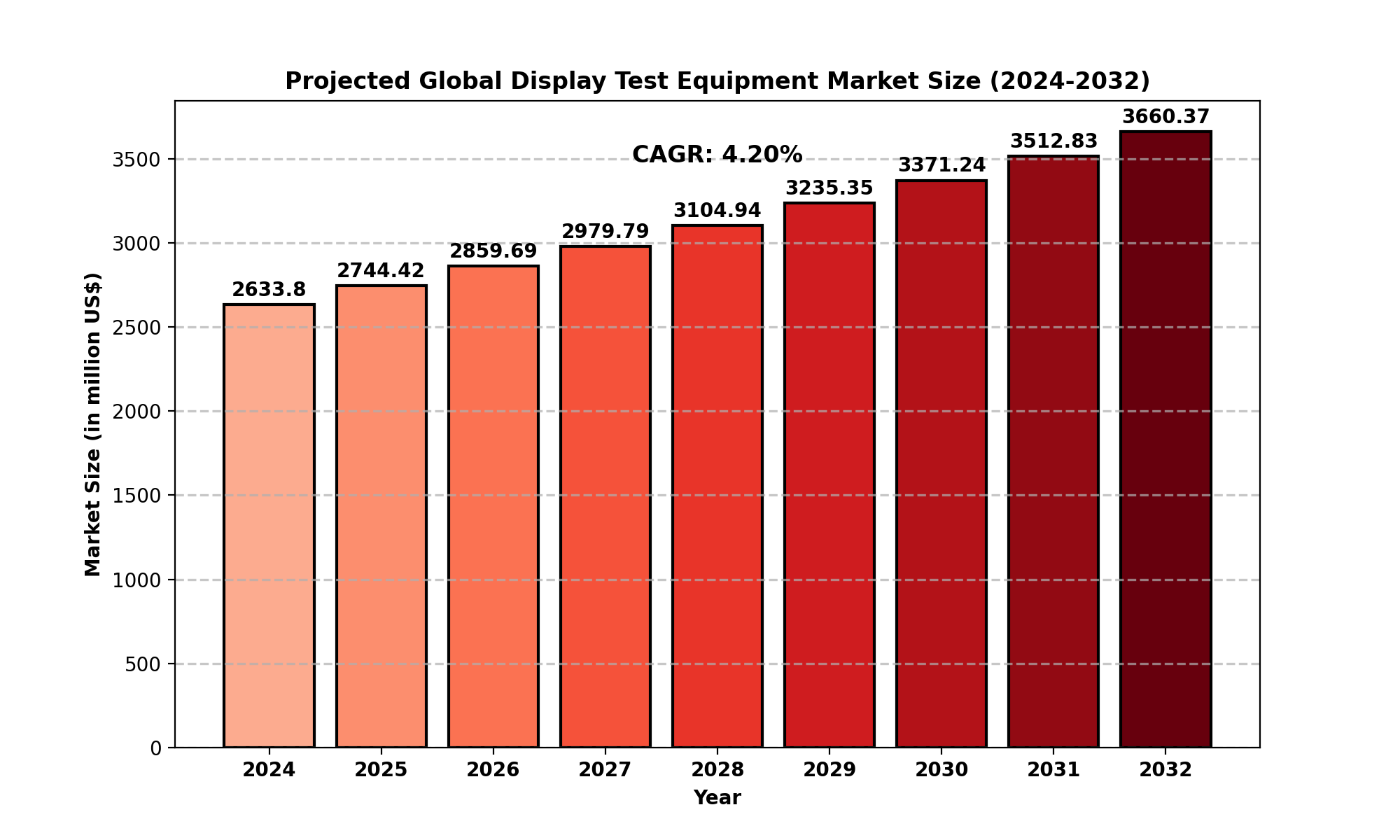TOP CATEGORY: Chemicals & Materials | Life Sciences | Banking & Finance | ICT Media
The global Display Test Equipment Market encompasses a range of specialized tools and technologies designed to assess and ensure the quality, performance, and functionality of display panels. These devices play a crucial role in the manufacturing process of various display technologies, including LCDs, LEDs, OLEDs, and other advanced display panels. The primary objective of display test equipment is to conduct optical, electrical, and functional tests that determine the precision, brightness, color accuracy, and overall performance of screens used in consumer electronics, automotive displays, and industrial applications.
The Display Test Equipment Market was valued at approximately USD 2,633.80 million in 2024 and is projected to grow at a CAGR of 4.20%, reaching USD 3,660.37 million by 2032.
The North American market alone was estimated at USD 736.60 million in 2024, with a projected CAGR of 3.60% during the forecast period (2025-2032).
The increasing demand for high-quality displays in smartphones, televisions, automotive dashboards, and industrial monitors is a major driver for this market growth.

Drivers
Growing Demand for High-Resolution Displays: The increasing popularity of 4K, 8K, and OLED screens in smartphones, laptops, TVs, and gaming monitors is pushing manufacturers to enhance display quality, leading to higher investments in testing equipment.
Technological Advancements in Display Manufacturing: Innovations such as micro-LED and flexible displays require precise and accurate testing to meet consumer expectations.
Rising Adoption of Display Technology in the Automotive Sector: The integration of digital dashboards, heads-up displays (HUDs), and infotainment systems in modern vehicles boosts demand for display test equipment.
Restraints
High Initial Costs: The expensive nature of advanced optical and electrical testing equipment limits adoption, especially among small and mid-sized manufacturers.
Complexity in Testing Advanced Display Panels: The transition to mini-LED and micro-LED displays adds complexity to testing processes, requiring specialized and expensive equipment.
Opportunities
Expansion of Smart Devices & IoT Applications: The proliferation of smart home devices, wearables, and industrial IoT screens provides new opportunities for market expansion.
Increased R&D Investments: Continuous research into AI-powered display testing can further improve automation and accuracy in quality control processes.
Challenges
Rapid Technological Changes: Frequent advancements in display technology necessitate constant updates to test equipment, posing a challenge for manufacturers to keep up.
Global Supply Chain Disruptions: Semiconductor shortages and trade restrictions can impact the availability of essential components for test equipment.
North America
Market Size (2024): USD 736.60 million
Key Drivers: High adoption of premium displays in consumer electronics, strong presence of tech giants, and rising demand for automotive displays.
Major Players: HB Tech, KOH YOUNG, Chroma.
Europe
Key Markets: Germany, UK, France, and Italy.
Growth Factors: Growing automotive display applications and increasing investments in advanced display technology.
Market Trend: Rising adoption of OLED and micro-LED technologies.
Asia-Pacific
Dominant Region in Market Share: Led by China, Japan, South Korea, and India.
Growth Drivers: Presence of major display manufacturers (Samsung, LG, BOE), high consumer electronics demand, and government support for advanced manufacturing.
South America & MEA
Emerging Markets: Brazil, Argentina, Saudi Arabia, UAE, South Africa.
Growth Potential: Increasing smartphone penetration and government initiatives for industrial digitization.
Key Companies
HB Tech
Yang Electronic
KOH YOUNG
ANI
KLA (Orbotech)
V-Tech
Young Woo
Chroma
Takano
Wuhan Jingce Electronic Group
Suzhou HYC Technology
These companies focus on R&D, strategic partnerships, and product innovations to strengthen their market position. The competition revolves around automation, testing speed, and accuracy enhancements.
By Type
Array Process Testing Equipment
Cell Process Testing Equipment
Module Process Testing Equipment
By Application
LCDs Testing
LEDs Testing
Geographic Segmentation
North America (USA, Canada, Mexico)
Europe (Germany, UK, France, Russia, Italy, Rest of Europe)
Asia-Pacific (China, Japan, South Korea, India, Southeast Asia, Rest of Asia-Pacific)
South America (Brazil, Argentina, Columbia, Rest of South America)
Middle East & Africa (Saudi Arabia, UAE, Egypt, Nigeria, South Africa, Rest of MEA)
1. What is the current market size of the Display Test Equipment Market?
The market was valued at USD 2,633.80 million in 2024 and is projected to reach USD 3,814.10 million by 2032, growing at a CAGR of 4.20%.
2. Which are the key companies operating in the Display Test Equipment Market?
Major players include HB Tech, KOH YOUNG, Chroma, KLA (Orbotech), Yang Electronic, and Suzhou HYC Technology.
3. What are the key growth drivers in the Display Test Equipment Market?
The primary growth drivers are increasing demand for high-resolution displays, advancements in display technologies, and rising adoption in automotive and industrial applications.
4. Which regions dominate the Display Test Equipment Market?
Asia-Pacific leads the market, followed by North America and Europe, due to the strong presence of display manufacturers and high demand for premium electronics.
5. What are the emerging trends in the Display Test Equipment Market?